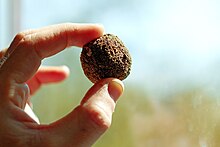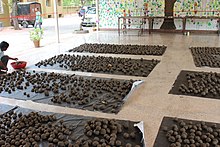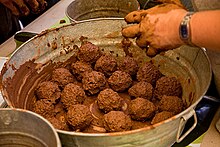Seed bomb

Seed ball also seed ball or Saatbombe (English bomb seed or seed ball , Jap. Nendo dango , 粘土団子 ) denotes a molded earth handy ball which Seed contains. Seed bombs are used in the guerrilla gardening movement as a method of sowing mainly in urban areas.
Construction and manufacture
A seed bomb usually consists of potting soil mixed with clay . The balls can be dried in the oven at a low temperature. A common mix consists of five parts red clay, three parts soil or compost, and one part seeds. With a part of water they are formed into small balls and dried for one to two days.
Inside the ball there are often seeds of annual plants (summer flowers) and traditional in Germany garden flowers, such as cornflower , Marigold , Tagetes , Sun , mallow and other species. The balls must be stored in a dry place so that the seeds do not sprout.
application
The seed bombs are thrown on any place with soil. The dry clay ball protects the seeds from birds and rodents. If it rains, the ball soaks up water and swells. The seeds begin to germinate and break through the walls of the sphere. The selection of the locations determines which of the sown plant species will thrive.
history
The seed bombs can be traced back to the Japanese rice farmer Masanobu Fukuoka . He had developed his method of nendo dango (seed ball) after the end of the Second World War, especially for the direct sowing of rice and barley on his fields, which were permanently tilled without plowing ( permaculture ) and thus also sown vegetables such as daikon radish in meadows and along roadsides. A group of young people who had lived on his farm since the 1970s and studied his techniques and the philosophy of doing nothing agriculture , as well as Fukuoka's book “One Straw Revolution” (title of the German Edition: "The Great Way Has No Gate" ) was published in the USA in 1978 and also made Fukuoka's techniques well known in the English-speaking permaculture scene. Fukuoka himself spread his experiences on trips to countries like Somalia or India . Fukuoka is remembered today in the guerrilla gardening movement.
Another independent development of the seed bombs is also being discussed, as the New York guerrilla gardening group Green Guerillas around the artist Liz Christy reported on the use of “seed bombs” in 1973.
The seed method itself seems to have been used by some of the Native American tribes .
Seed bombs are now being manufactured and sold commercially.
Conservation criticism
The Federation for the Environment and Nature Conservation Germany (BUND) assesses many seed bombs as questionable, as seeds from cultivated ornamental plants are mostly used for their production . At the same time, the BUND emphasizes that the urban natural equipment is characterized by a high proportion of cultural forms and neophytes .
Web links
Individual evidence
- ↑ On "seed391.wordpress.com" (PDF file; 208 kB)
- ^ Artist without a name
- ↑ cf. also introduction by the translator Larry Korn in: Masanobu Fukuoka: The great way has no gate. Food - Cultivation - Life. 3rd edition, Pala-Verlag, Darmstadt 2017, ISBN 978-3-89566-206-5 , pp. 13-21. For Fukuoka's description of his technique of wrapping seeds in lumps of clay (pellets), cf. P. 48f.
- ↑ Seedballs: from Fukuoka to Green Guerrillas. Retrieved July 10, 2011.
- ↑ Andrea Bellemy: A brief history of the seed ball. Retrieved July 10, 2011.
- ^ Weser Kurier: Seed bombs from Northern Germany
- ↑ Andreas Faensen-Thiebes: Stadtnaturschutz - BUNDstandpunkt 4. (PDF file; 1.5 MB) Bund für Umwelt und Naturschutz Deutschland (Ed.), Berlin, June 2012, p. 17 (Section 4.3.6 Guerilla Gardening).
- ↑ Andreas Faensen-Thiebes: Stadtnaturschutz - BUNDstandpunkt 4. (PDF file; 1.5 MB) Bund für Umwelt und Naturschutz Deutschland (Ed.), Berlin, June 2012, p. 19 (Section 5.3 Dealing with Alien Species).





